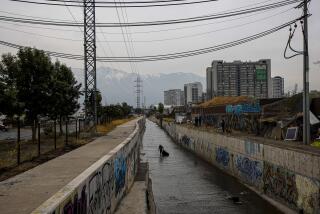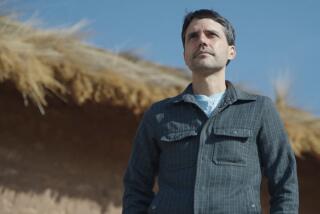South America’s Poor Are Easy Targets for Cholera : Disease: So far, it has killed 1,000 Peruvians and has spread to Ecuador, Colombia, Brazil and Chile.
- Share via
LIMA, Peru — Cholera finds most of its victims among the impoverished masses, but sometimes it is more selective. Congressman Hernan Lazo, 44, said he caught the dreaded disease in the dining room of the Chamber of Deputies, Peru’s lower house of Congress.
He ate pig’s feet with peanut sauce and a fruit salad there on April 1. “I had lunch at 1:30 and at 4 I was sick,” Lazo recalled. “I was in a cold sweat, pallid.” By 10:30 that evening, he looked so bad that friends took him to the hospital. “They just took me. I didn’t want to go.”
Lazo, a rotund 200-pounder, spent four days in the hospital, receiving 5.2 gallons of intravenous fluid to combat dehydration. But he said his main defense against cholera was his extra weight.
“If it weren’t for that, I’d be up there with St. Peter,” he said.
Since late January, more than 150,000 Peruvians have come down with cholera and more than 1,000 have died. The disease has spread into neighboring Ecuador and Colombia, and last week cases were detected in Brazil and Chile.
It is the continent’s first cholera epidemic since early in the century, and already it is a major one.
“It’s as big as anywhere,” said Dr. Myron Levine, an epidemiologist and cholera specialist from the University of Maryland who visited Peru recently. “Cholera has returned to South America with a vengeance.”
Cholera can be a frightening disease, spreading rapidly through the population. It violently invades the intestinal tract, quickly draining the body’s vital fluid. The main symptom is severe diarrhea, and sometimes vomiting, which if untreated can cause irreversible dehydration and death in less than a day.
Levine and other experts, recognizing South America’s vulnerability to a disease that thrives in squalor, fear that the epidemic may become continental in scope. They fear that death rates may climb as it moves into more poor, isolated areas where people are most susceptible. And they fear that cholera could settle in for a long stay in some regions--becoming endemic in South America as it is in parts of Asia and Africa.
Tiovaldo Trinidad, 26, was infected with the disease in San Juan de Lurigancho, a sprawling slum on the outskirts of Lima where he lives and hawks cheap watches on the street. He often buys his lunch from other street vendors who sell food and drink. The day he came down with cholera, Trinidad had eaten ceviche, a dish of raw fish marinated in lime juice and spices, and chicha, a beverage made from corn.
“Later, I went home,” he recalled from his hospital bed. “I started feeling sick. That night, I started to vomit.”
His brother-in-law, a construction worker, carried him in a wheelbarrow to a small public health clinic in Lurigancho. Four hours later, the clinic sent him in a taxi, with a plastic tube for intravenous fluid sprouting from his arm, to the Dos de Mayo Hospital near the center of the city.
Dos de Mayo is one of several public hospitals in Lima that were crowded with cholera patients as the epidemic spread through the city’s pueblos jovenes, or new towns, dreary slums of makeshift homes that lack water and sewage lines.
Studies show that Lima’s main river, the Rimac, and nearby Pacific coastal waters are contaminated with Vibrio cholerae, the cholera bacterium. It has been found in the innards and skin of coastal fish traditionally used by the poor to make ceviche, one of Peru’s most popular dishes. Even if made from uncontaminated deep-sea fish, ceviche can pass the Vibrio from a food handler’s dirty hands to the mouth of another victim.
To catch cholera, a person must swallow the bacterium. It is not transmitted by mosquito bites or sneezes. Most people who ingest V. cholerae don’t get seriously ill; stomach acids are a strong defense.
However, many people become “healthy carriers.” They show no symptoms but their excrement carries live bacteria that can make others sick. That is how an epidemic can spread with the speed of an ugly rumor in a country where half the people live without water and sewer services and where standards of hygiene are often primitive.
The Peruvian epidemic started in three cities along the country’s northern coast. In the last week of January, the first cases of cholera were reported almost simultaneously in Chancay, a few miles north of Lima; Chimbote, 250 miles farther north; and Piura, 300 miles north of Chimbote. Officials speculate that the bacterium was brought in by a ship from Asia.
The coastal outbreaks spread rapidly. The epidemic soon was raging in the pueblos jovenes of Lima, a city of more than 6 million people.
In the first few days, the death rates were high because the epidemic caught Peruvians by surprise. But the country’s health-care network geared up quickly to handle the surging load of cases. A publicity campaign helped boost public awareness of what to do about cholera and how to prevent it--urging Peruvians to boil or chlorinate drinking water, to wash their hands before handling food, to avoid unsanitary food vendors and not to eat raw foods, especially ceviche.
The cholera epidemic appeared to be subsiding when the “Ceviche War” broke out.
While Carlos Vidal, then the minister of health, insisted that fish could transmit the cholera bacterium, fishermen and fish merchants complained that the cholera scare had unfairly dried up their business.
Then President Alberto Fujimori, an agronomist and academic who was elected last year, entered the fray. With television cameras rolling, Fujimori fearlessly ate ceviche and sushi for all the world to see. His fisheries minister, Felix Canal, also made a public point of eating ceviche.
As ceviche became officially respectable again, the number of cholera cases surged anew. Canal reportedly came down with a case. (He has denied it but a Health Ministry source confirmed it.)
Many Peruvians accused Fujimori of acting irresponsibly. “Cholera is a case in which the president has personally killed some 500 people,” a prominent editor said privately.
Health Minister Vidal resigned and Fujimori appointed Victor Yamamoto to replace him. The Health Ministry has continued to advise against eating ceviche, and Fujimori has not eaten it again on television.
But Health Ministry official Eduardo Salazar said the Ceviche War set back the anti-cholera efforts. “A period of the campaign was lost because of the different messages,” Salazar said. “The population was confused.”
The Peruvian epidemic is the latest stage of the world’s seventh cholera pandemic, which began in Indonesia in 1961 and spread through other parts of Asia, the Middle East and Africa. Previous pandemics began in 1817, 1829, 1853, 1863, 1881 and 1899.
The disease first reached U.S. shores in 1832, and federal health officials say that since 1960 a few dozen cases of the disease have been imported into the United States, including one incident last week, in which a physician who had attended a Peruvian conference was found to be infected.
The Colombian city of Cartagena reportedly lost one-third of its population to cholera in an 1849 outbreak, which provided the backdrop for Nobel Prize-winning author Gabriel Garcia Marquez’s 1988 romance, “Love in the Time of Cholera.” In Chile, at least 23,000 people died between 1886 and 1888 in another cholera wave.
Although the last two pandemics swept through neighboring countries, they did not hit Peru. Experts speculate that Peru’s small population then, combined with the desert climate of its coast, gave little opportunity for the cholera bacterium to propagate.
But Peru now has a population of 21 million, most living in poverty made more squalid by years of economic crisis.
More than half of Peru’s workers are unemployed or underemployed. Uncounted thousands try to make a living by selling whatever they can on Lima’s grimy sidewalks, which are often so crowded with vendors that pedestrians overflow into the vehicle traffic. Many vendors sell ceviche, chicha, sandwiches and other prepared food in appallingly unsanitary conditions. Vendors have no place to wash their hands. Plates and glasses are rinsed over and over in the same pails of murky water.
Cholera is not the only disease that flourishes in Peru’s poverty. Typhoid fever is endemic. Intestinal infections of all kinds make diarrhea as common as the cold. Dehydration from diarrhea is the No. 2 killer of Peruvian babies after respiratory infections. Peru has one of the highest infant mortality rates in the hemisphere: 80 of every 1,000 Peruvian babies die before they are 1 year old--more than 50,000 a year.
In an effort to lower the infant mortality rate, UNICEF, the U.N. Children’s Fund, began three years ago to organize women in poor neighborhoods to promote hygienic practices, such as boiling water. They also distribute millions of packets of rehydration salts. The salts, which include sodium and potassium, are dissolved in water and drunk. If taken early, such fluids often can keep cholera from reaching a life-threatening stage.
“That explains a death rate that is one of the lowest in the history of cholera,” Paolo Basurto, UNICEF representative in Peru, said of current conditions. While some African and Asian countries have recorded fatality rates of 10% and even 20%, fewer than 1% of Peru’s cholera victims have died.
Despite a wage strike by auxiliary workers in the Peruvian public health system, hospitals and neighborhood clinics have responded well to the crisis, foreign experts say. But in some areas of Peru, health services are so scarce and living conditions so primitive that cholera is as lethal as it might have been a century ago.
The United States is providing technical aid and medical supplies to help Peru fight the epidemic, but there is no fast way to overcome the backward conditions in vast areas where high death rates could occur. High rates are feared elsewhere in Peru’s Andean highlands and in its eastern Amazon region, where cholera is slowly creeping into isolated villages.
From there, the disease could move into Brazil’s vast Amazon region, where the first cases were reported last week.
The Peruvian epidemic spread north into Ecuador, and so far more than 5,000 people have caught cholera and 100 have died, the Ecuadorean Medical Federation reported. And it has moved up the Pacific coast into southern Colombia, where more than 70 have fallen ill.
Dr. Jose Ignacio Santos, a Mexican medical researcher who was in Peru for a recent conference, said his country--far to the north--is also threatened by the epidemic. “It has to get there,” he said. “It’s a question of time.”
More to Read
Sign up for Essential California
The most important California stories and recommendations in your inbox every morning.
You may occasionally receive promotional content from the Los Angeles Times.













